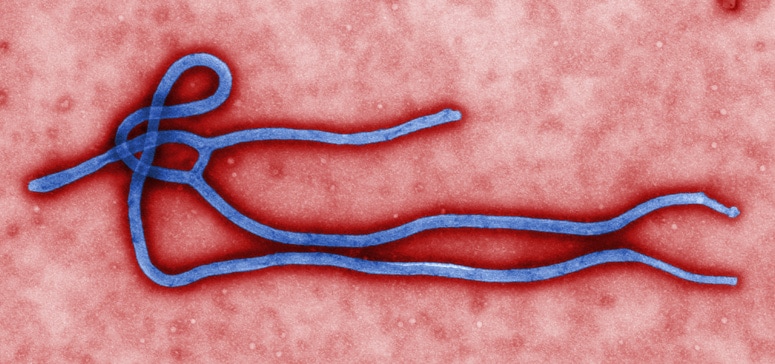No one knows where it came from. No one knows where it will turn up next. All we know is that when it does resurface it may take mankind with it. Sounds like something straight out of a comic book doesn’t it? Well I wish, the virus described above is Ebola. It kills nine out of every ten people it infects. Wreaking devastation on the body of its victims. The disease starts mildly with a headache and fever but swiftly moves to uncontrollable internal bleeding. Within days, organs turn into jelly like pulp which patients expel through every orifice eventually dying in a massive pool of blood.

imagecredit: cdc.gov
There are five strains of the Ebola virus, each named after countries and regions in Africa: Zaire, Sudan, Tai Forest, Bundibugyo and Reston. The Zaire Ebola virus is the deadliest, with a mortality rate of 90 percent. It’s the strain that spread through Guinea, Sierra Leone and Liberia, and beyond during the recent ebola epidemic. Scientists speculate that flying foxes probably brought the Zaire Ebola virus into cities.
The closest documented global outbreak was the Spanish influenza of 1918. It lasted for about 2 years infecting around 500 million people across the globe killing anywhere from three to six percent of the global population. The outbreak was partially contained due to the transport constraints of the time. Still during a 2 year period, it managed to infect 2-3rds of the world population and kill 3-6% of the global population. Killing at a rate of a million a week. What’s even more frightening is that we don’t even know where the Spanish Flu came from – it was just called the “Spanish Flu” because the press in Spain were the first to report on it. Flu’s are pretty common almost all of us experience it at some point in our lives and it is usually mild and non-deadly. However every 20-40 years or so the virus undergoes a dramatic mutation , usually this occurs when a wild flu virus circulating in ducks and farm poultry meets a pig virus and exchange genes. This process is called Antigenic shift and has occurred throughout human history.

NIAID illustration of potential influenza genetic reassortment
Like AIDS, Ebola is thought to have come from central Africa and it is no coincidence that they have emerged from the same ‘hot zone’. The World Health Organisation(WHO) fears the rapid settlement of jungle areas, combined with rapid population growth and increased mobility may be creating the ideal conditions for the explosion of unfamiliar diseases.
Being a virus Ebola is extremely difficult to treat medically. There are still debates as to whether viruses are living organisms or not. Because Viruses actually take over the cells of their victims , it’s hard to stop the virus without affecting the healthy cells at the same time. The usual method is to develop a vaccine to equip the immune system to fight the infection. However as of now no vaccines have been approved for clinical use in human beings and Ebola has exhibited a cunning ability to mutate. But on the bright side in December 2016, a study found the VSV-EBOV vaccine to be 70–100% effective against the Ebola virus, making it the first proven vaccine against the disease.
Ebola is currently one of the deadliest viruses known to man and its effects can make HIV look like a bad day at the office. Ebola causes death within 10 days something AIDS may take 10 years to do. Being the richest man on the planet there isn’t a lot of things that can scare Bill Gates. But in an interview to Vox, Mr Gates described his worst fear. A genetically mutated virus. Mr Gates stated the probability of an outbreak far worse than ebola in his lifetime , ie next couple of decades is well over 50%. In this age of jet travel one infected person or animal could trigger an epidemic anywhere. Estimates show that a global outbreak could kill more than 330 million . Behind Gates’s fear of pandemic disease is an algorithmic model of how disease moves through the modern world. He funded that model to help with his foundation’s work on eradicating polio. But then he used it to look into how a disease that acted like the Spanish flu of 1918 would work in today’s world. The results were shocking, even to Gates. “Within 60 days it’s basically in all urban centers around the entire globe,” he says. “That didn’t happen with the Spanish flu.”The basic reason the disease could spread so fast is that human beings now move around so fast. Gates’s modelers found that about 50 times more people cross borders today than did so in 1918. You can read the full Vox article here.
In February 2003 a Chinese doctor arrived in the Metropole hotel Hong Kong feeling unwell. Unknown to him he was harbouring a new animal origin virus called SARS(Severe Acute Respiratory Syndrome). Within 24 hours of checking in 16 others had been infected. And within a week 5 boarded a plane to foreign destinations. Spreading the virus to Vietnam, Singapore and Toronto. Flight between international cities were quickly grounded and thanks to other emergency measures a pandemic was averted. By the time the outbreak was over 4 months later SARS had infected around 1000 people in around 29 countries worldwide.
However all is not lost, modern medicine has come a long way since the the Spanish Influenza. We can now detect outbreaks before they become pandemics and take actions to mitigate their impact before they spread too widely. Also massive investment into the field of bioengineering means we will soon see vaccines and related cures soon, rescue forces and other crisis management teams are also being effectively trained in case of such an outbreak.

Leave a comment